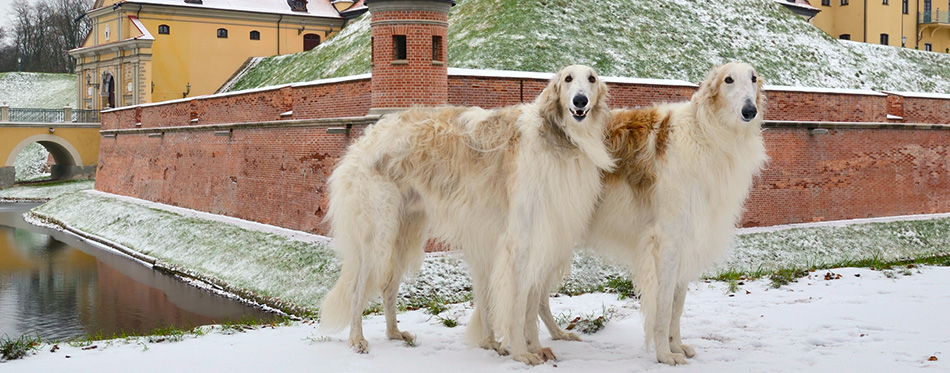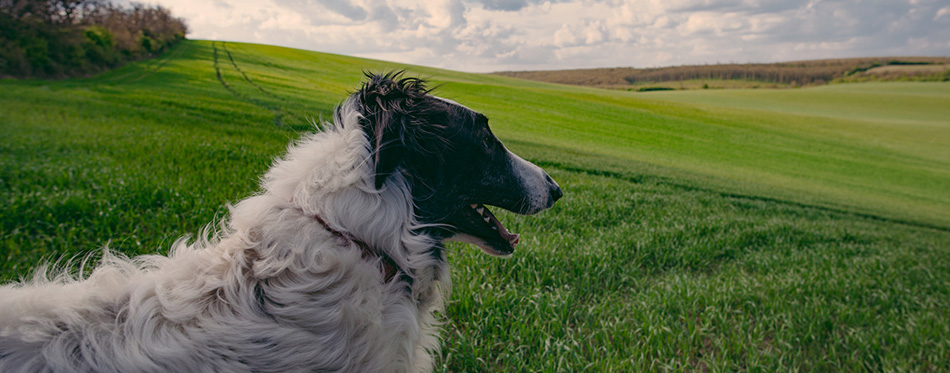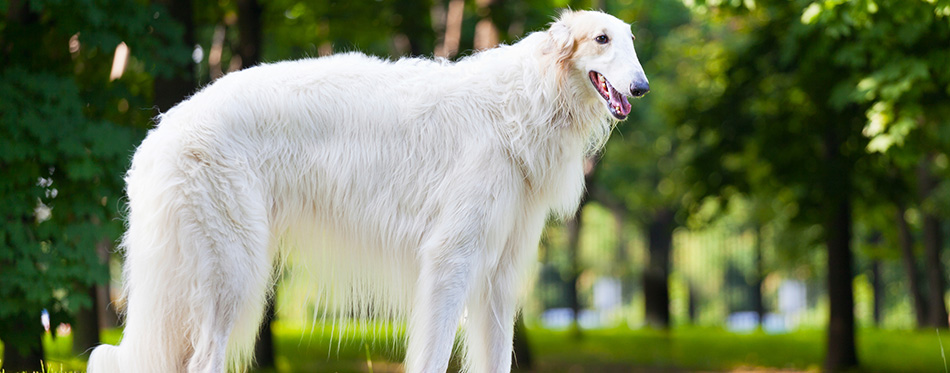Unique in their elegant appearance, Borzois or Russian Wolfhounds have been a popular choice of dog for hundreds and hundreds of years. While they may have an ultra-fancy appearance, they are actually very playful dogs who are often perfectly happy rolling around in the mud!
Their strong hunting instincts still impact a lot of their behavior patterns, so you need to be careful when you are exercising them as there is every chance that they will dart off after potential prey and will be very tricky to track down again. But they also enjoy spending time indoors; in fact, they have been compared to cats in the way that they enjoy being alone, but are happy with company as well.
If you are thinking of bringing a Borzoi into your household or you would like to know more about the one you own already, this article is for you. We are going to go into more detail right from their origins, moving into the present day. We will also talk more about caring for Borzoi dogs to help you with pet ownership. So, let’s get started right from the beginning – the history of the Russian Wolfhound.

History of the Russian Wolfhound
Borzois got their original name of the Russian Wolfhound as this was where they were first recorded in 1650, where they were aristocratic pooches. The story goes that a Duke crossed some Arabian greyhounds with Russian sheepdogs. The former had the quick hunting instincts that he was looking for, while the latter has the warm coats to keep them alive during the long Russian winters.
During the 19th century, they were used during wolf hunts, where they hunted the fearsome creatures in small groups. Sadly, many were killed during the Russian Revolution of the early 20th century. Outside of Russia, Queen Victoria helped to popularize Borzois.
Others talk about a more complicated lineage that goes back to the Middle Ages, so we can’t tell their story with complete certainty.
Quick Facts About the Russian Borzoi
Strong, swift, and graceful, this is a tall dog with a long, narrow head, small ears, and a long tail. All of this adds up to the elegant appearance that they are so well known for. Borzoi dogs are compared to Afghan Hounds or Saluki, but they are taller and heavier in weight. On average, this will be anywhere between 75 and 105 pounds. Males can reach up to 28 inches tall, while females are only a little bit shorter at 26 inches tall.
As for puppies, their heads need time to grow into their distinguishing shape. In fact, it takes around three years for their head to fully develop. It starts off curved but will straighten up over time.
Something that is not commonly known about Russian Wolfhounds is that they can’t hold a lot of food inside their stomachs, which can lead to bloating. It is better off feeding them smaller meals several times a day rather than offering big meals.
Borzois are known for their speed and hunting instincts. They will often pick up a scent and follow it with little regard what they are knocking over along the way. You should keep them on a leash when it looks like they are in that hunting mode. If you are looking for more options, check out our guide on the best dog leashes.
Things You Should Know About Borzoi
Beyond the history and the quick facts above, there are plenty of other things that you should know before taking a Borzoi home. We have split these things into several different categories: health, training, exercise, nutrition, grooming, and temperament. In each of these sections, we reveal a little bit more about what it takes to own your own Borzoi dog.

Borzoi Health
Every dog breed has some specific health concerns that you need to watch out for, and the Borzoi is certainly no different. The typical lifespan of a Borzoi dog is between 9 and 14 years, but you can do a lot to influence this by keeping them in good health.
Since they have such deep chests, they suffer a higher risk of a gastrointestinal condition known as bloat. Heart disease is a growing issue, but one of the best ways of keeping this at bay is by preventing obesity. A good diet and plenty of exercise can go a long way towards this. Another concern is hypothyroidism, which affects nearly one in five Borzoi.
Dure to their long limbs, orthopedic problems are prevalent. Also, there are a range of skin issues – many of which come from allergies. Keep a close eye on your dog for any signs of itching or irritation.
If you get the dog as a sighthound, they need to have the space to run and develop good muscle tone. However, you need to keep this area enclosed as they could be in danger from passing vehicles. Once their hunting instincts kick in, they will not respond to your commands any longer. As you would expect, a range of musculoskeletal injuries can occur because of this.
In terms of general care, Borzoi enjoy living comfortable lives as house dogs. Although they enjoy being in homes with yards, many will get by with regular exercise.
Russian Wolfhound Training
Borzoi dogs are highly intelligent and capable learners, but this doesn’t necessarily mean that they are easy to train! In fact, many of them are very independent-minded, which means that they aren’t as concerned about pleasing their owner. Their stubbornness can also prove to be a major issue. You should take a gentle approach to training – albeit one that remains consistent. You are going to have to display high levels of patience – and having plenty of treats to hand certainly won’t hurt either! Never use negative or harsh punishments when you are training a dog as this can lead them to do the opposite of what you want.
Short training sessions are best, as this is a dog that tends to get bored very quickly if they are bombarded with too much, too quickly. You should also stick to a clearly established schedule so you get into a nice routine
As for house training, this shouldn’t prove to be too difficult. Crate training is also a good idea as it stops your puppy from getting into trouble when you are not directly able to supervise. In fact, with the right training, many Borzoi come to enjoy being inside their crates. Find out more about dog crates here.
Borzoi Exercise
While Borzoi dogs enjoy spending time lounging indoors when they can, they need a lot of exercise to stay in peak physical condition. A long daily walk is essential, but the opportunity to run off the leash is always present, so make sure you purchase a durable, high-quality leash for your Borzoi. But they can’t be expected to get by with just simple walks around the block. A large fenced area is ideal as it will stop your dog from spotting some potential prey, running off, and never coming back again. Bear in mind that the fence needs to be high enough that your dog doesn’t simply leap over the top of it. Borzoi can jump up to six feet.
A great way of maintaining your own fitness is taking your dog along with you as a running companion. Some people do the same for cycling, but you need to be warned that Borzoi can quickly run off after prey, which poses a risk of you getting knocked off your bike. Since they are from a hunting background, they are naturally good at games like fetch, as well as other dog sports such as agility training and lure counseling.
While they need regular exercise, most Borzois aren’t particularly energetic dogs. Of course, activity levels vary from dog to dog. But you are unlikely to find them bounding around the house in the same way that other dogs enjoy.
Russian Wolfhound Nutrition
Now we come onto another important aspect of owning a Russian Wolfhound – nutrition. As you would expect with a dog with a huge frame and beautiful coat, you need to feed them properly. Choosing a premium dog food is important. First up, the food needs to be rich in protein. If you have a puppy, a minimum of 2000 calories a day is recommended. After the growing years are over, your pup will eat less. Plenty of fats are also important as these help to keep up the energy levels of your dog.
Look out for Omega-3 and Omega-6 fatty acids, which help to boost immune system health, as well as leaving their hair and skin looking its best. Zinc is also important in this task.
Before introducing any new food to your dog, it is always worth consulting with your vet or animal nutritionist to get the lowdown on whether they are okay or not. Some owners like to offer a raw diet made up of meat, fruit, and vegetables, but you need to know exactly what you are doing before attempting anything like this.
For more guides on choosing the right dog food, you may wish to check out our reviews of the best dry dog food, organic dog food, grain free dog food, wet dog food and puppy food.
Borzoi Dog Grooming
Borzoi dogs possess a long, silky coat that can be any color combination. The texture can also vary between flat, wavy, or curly. Around their ears, head, and the front of their legs, the hair is short and smooth. Around their necks, they have a curly frill. And it is their long and poofy tails that they are especially well known for.
You should brush your Borzoi’s coat on a weekly basis using a pin brush. The areas that you need to focus on include around their ears and hind legs as these are particularly likely to develop mats. Russian Wolfhounds shed their fur more on a seasonal basis, which means they need more frequent brushing during this time.
It is important that you get into the good habit of brushing your dog’s teeth to protect their dental hygiene. Twice or three times a week is a good rule of thumb – but daily brushing is even better if you can commit to it. This is your best bet in preventing gum disease and bad breath. You should also trim your dog’s nails two or three times a week to get rid of tartar and bacteria. If you have hard wooden flooring at home, you will know when the time is right to trim your dog’s nails as they will start clacking on the floor! Not only is keeping your dog’s nails short good for them, it is also good for you as you are likely to get your legs shredded every time they jump up otherwise!

When you are grooming your dog, this is the ideal opportunity to look inside their ears and mouth to make sure everything is looking okay. Catching any problems early is the best way of getting them cleared up as soon as possible.
Grooming your dog doesn’t have to be a major effort. You can turn it into a nice experience for both of you with plenty of treats, praise, and the opportunity to form a closer connection with your canine companion.
For more help on dog grooming, you may wish to read our guides on the best dog nail grinders, dog dryers, dog clippers, dog grooming tables, dog grooming clippers and dog drying towels.
Borzoi Temperament
Borzoi dogs are known for their sweet and loyal nature – certainly around their family once you have overcome the ‘getting to know them’ obstacle. Also, they possess a high level of intelligence, but they can be challenging to train as they are so independent-minded and don’t care so much about pleasing their owners. You need to be the one clearly demonstrating that you are in charge, but you should still show a gentle training technique rather than one that is too harsh.
As we have talked about before, Borzoi are hunters and will dart off after small animals – even if you try to call them back again. You can’t trust them off the leash in the same way that you can other dogs. If you have any smaller animals at home like rabbits, hamsters, guinea pigs, and cats, you need to be especially careful with them. They can be socialized with other animals like cats from a young age. As for children, they don’t take so well to rough play, so you should consider whether your kid can be warded off doing this.
Most Borzois are fairly quiet dogs. They don’t bark too often and can’t be used as guard dogs as they don’t have the territorial instincts for it – even though they may look like they could be large and intimidating! Also, they will rarely show much aggression. And unlike other canines, Borzois are adept at keeping themselves clean. As you can see from the previous section, grooming doesn’t need the same level of effort that it does for other longer-haired species.
While they may be independent and strong-willed in what they want to do and what they don’t, the Borzoi is still a dog that craves companionship, which is just one of the reasons why they are so popular. In many ways, they are like cats in this regard – you don’t need to be supervising them all the time. Borzoi dogs are generally trusting creatures who don’t display much in the way of shyness. However, they can sometimes be a little distant with strangers until they get to know them better.
Final Thoughts
Borzoi are known for their loyalty and calm demeanor, which make them the ideal choice for many dog enthusiasts. However, they can be tough to train and are fairly stubborn. Also, you need to keep an eye on them as all the training in the world is not going to subdue their instincts to dart after small animals. While they love to spend time at home as well, they are better off growing up in a house with a backyard and they are certainly not a suitable apartment dog.
You also need to decide whether you are going to adopt an adult or a puppy. The older dogs have the advantage of already being housetrained and knowing basic commands, which can make your life so much easier. You can go down the route of adoption in this case. However, if you do decide on a Borzoi puppy, you are better off going to a professional and reputable breeder. Puppies tend to range between $1000 and $2000. If anyone is offering a price that seems to be suspiciously low, you need to be very careful as they may not be a competent breeder. Unlike some other puppies, they are intuitive and well-mannered, which makes them the ideal companion for families. But don’t be fooled into thinking that you are making life easy for yourself – this is never the case with puppies!
But when you get a Borzoi dog, you are not getting a crazy dog who is going to keep you up at night with their incessant barking. You are getting a quiet and gentle dog who can be taught to socialize well and become an integral member of your household.
Source:
- Showing Borzoi in Obedience – Borzoi Club of America

